Event-Based Vision Sensor Lifetime Degradation in Low Earth Orbit
Abstract
1. Introduction
1.1. Related Work
1.2. Background
2. Methods
2.1. Noise or Signal?
- Hot Pixels—pixels that record more events than expected;
- Boring Pixels—pixels that record events at a constant rate;
- Row/Column (RoCo) Errors—entire rows or columns of pixels that record events in an unusually short time period;
- Lonely Events—events that occur in a highly isolated manner in time or space.
2.2. Algorithms
2.2.1. Hot Pixels
2.2.2. Boring Pixels
2.2.3. Row/Column (RoCo) Errors
2.2.4. NNb Events
2.2.5. EDF Events
2.2.6. Cold Pixels
3. Results
3.1. Ram
3.1.1. Ram Default Biases—Full Mission
3.1.2. Ram 2024 Default Biases
3.1.3. Ram Pixel Counts
3.2. Nadir
3.2.1. Nadir Default Biases—Full Mission
3.2.2. Nadir 2024
3.2.3. Nadir Pixel Counts
4. Discussion
4.1. Radiation Environment
4.2. Origin of Noise Types
5. Conclusions
Supplementary Materials
Author Contributions
Funding
Institutional Review Board Statement
Informed Consent Statement
Data Availability Statement
Acknowledgments
Conflicts of Interest
Abbreviations
| ISS | International Space Station |
| EVS | Event-Based Vision Sensor |
| NNb | Nearest Neighbor |
| EDF | Event Density Function |
| ISI | Inter-Spike Interval |
| AISI | Average Inter-Spike Interval |
Appendix A. Methodology
Appendix A.1. Three-Dimensional Plots







Appendix A.2. Parameters
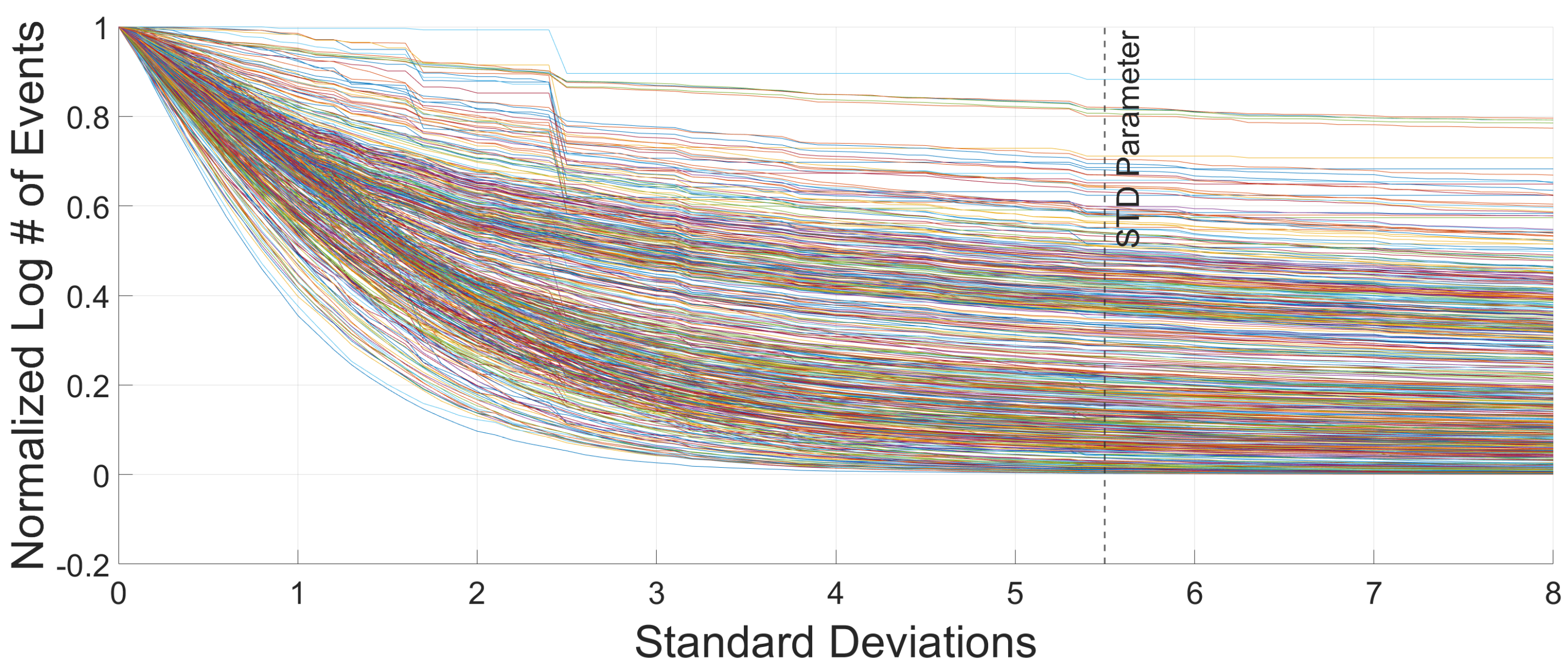

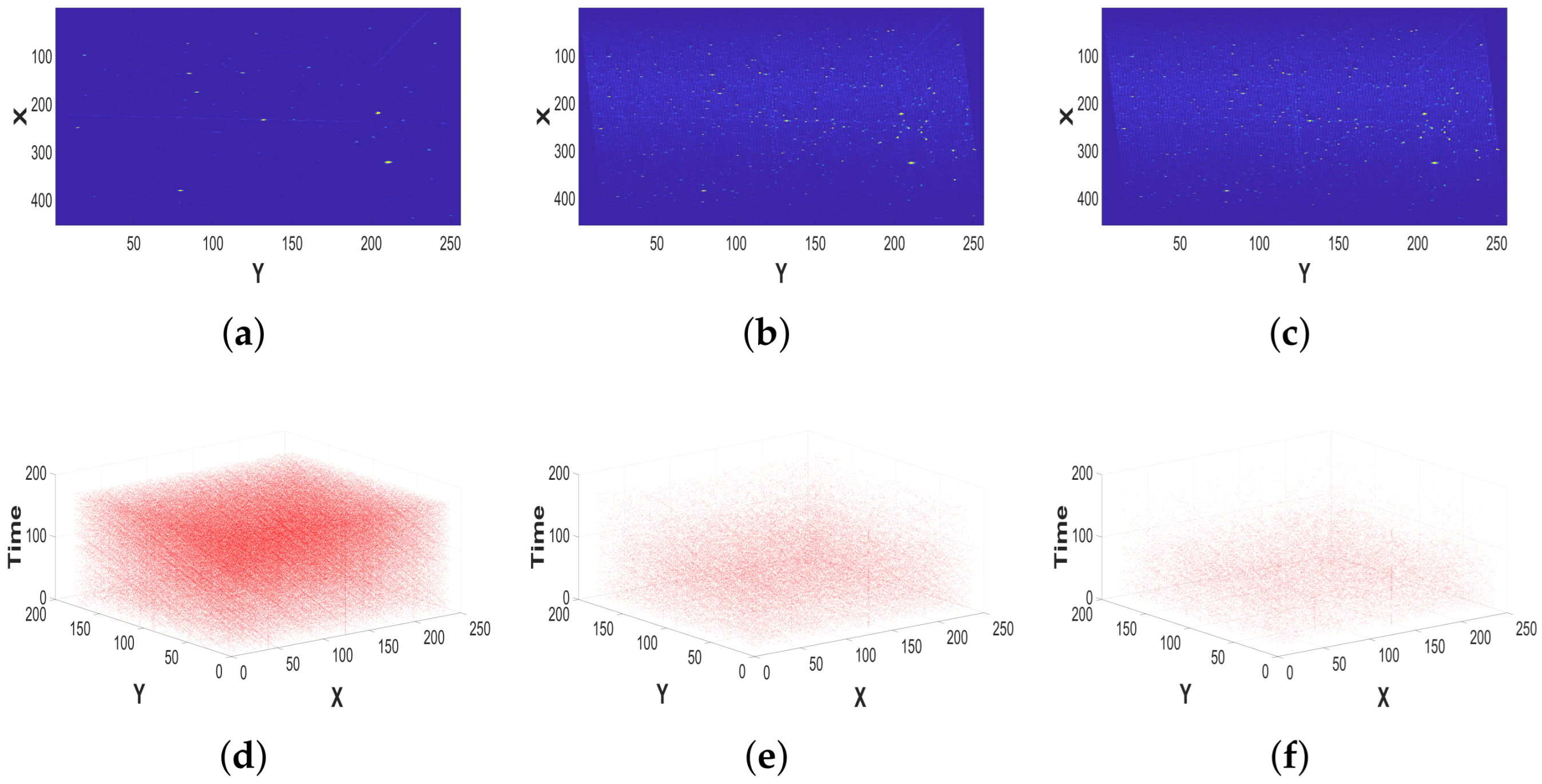
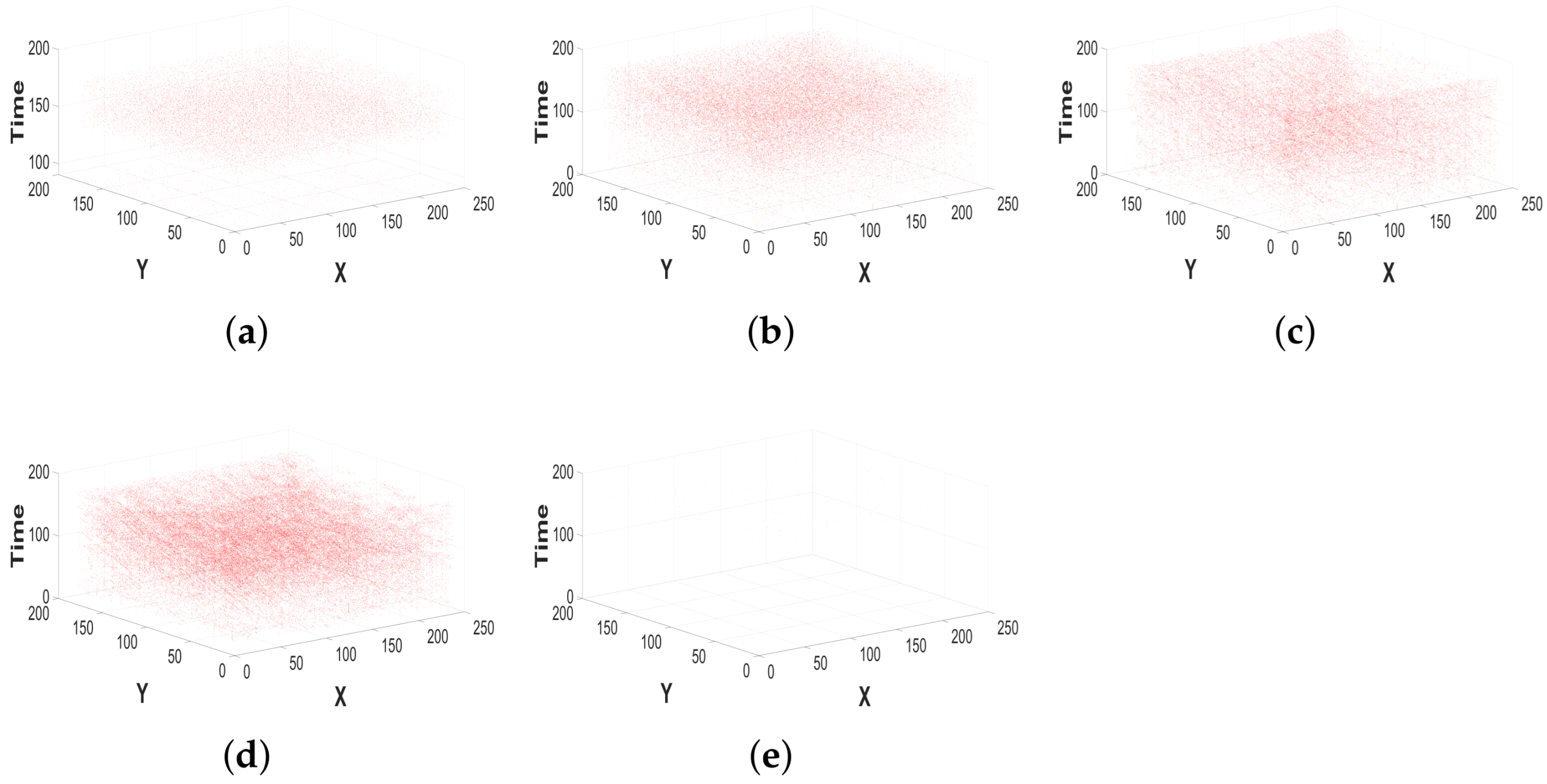
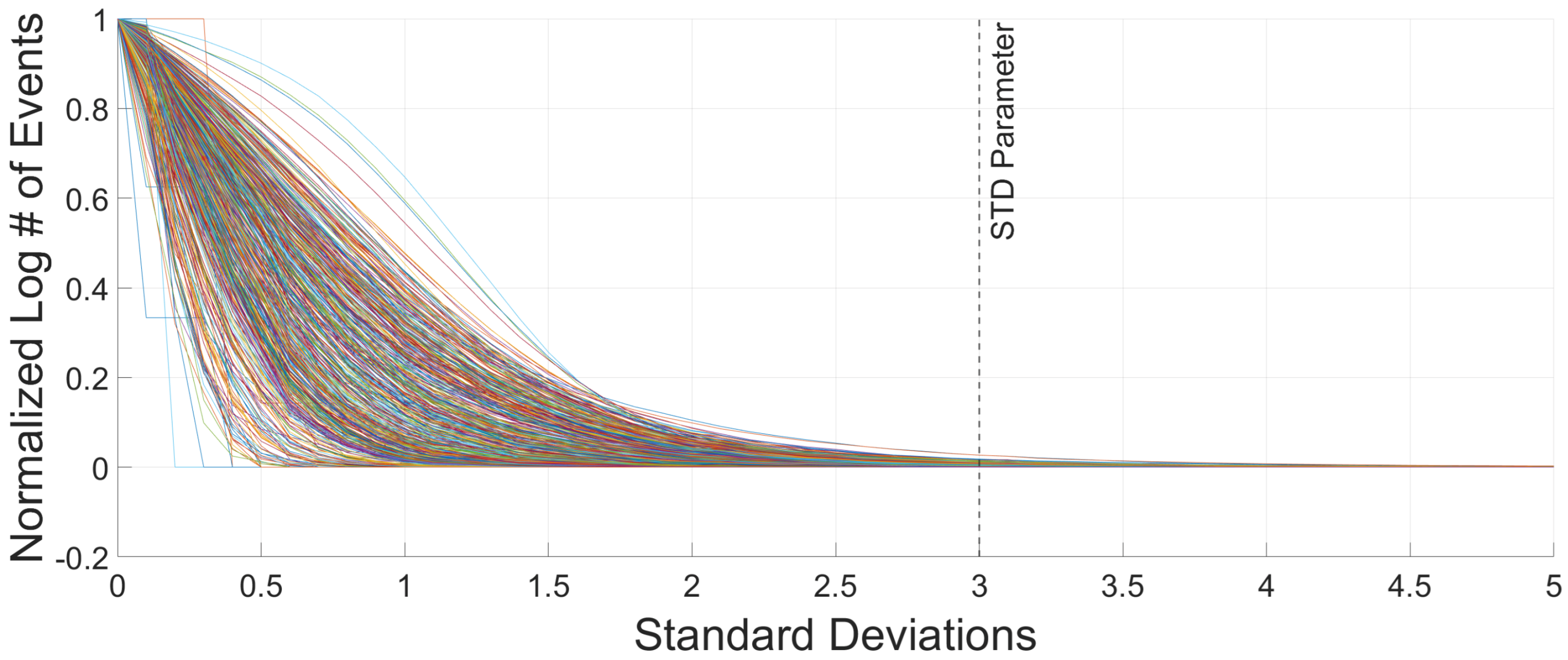
Appendix B. Results
Engineering Design Unit Comparison
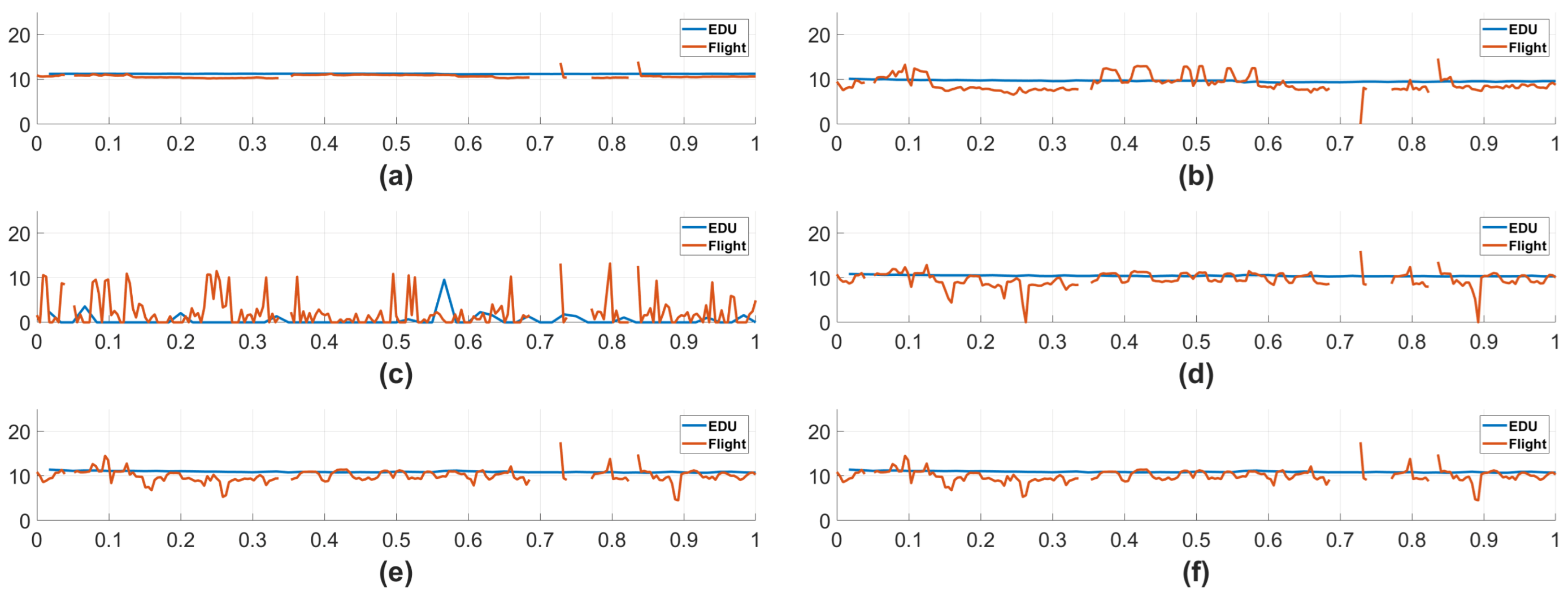
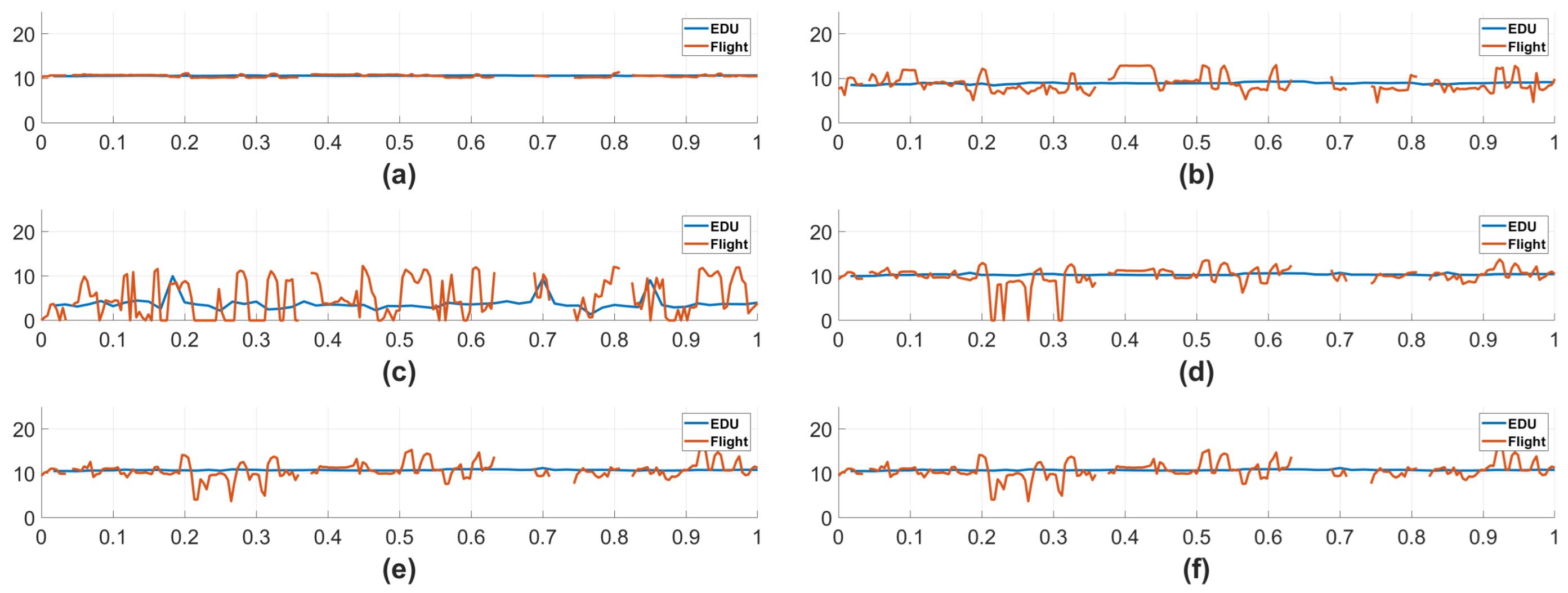
References
- Lichtsteiner, P.; Posch, C.; Delbruck, T. A 128 × 128 120 dB 15 μs Latency Asynchronous Temporal Contrast Vision Sensor. IEEE J. Solid-State Circuits 2008, 43, 566–576. [Google Scholar] [CrossRef]
- McHarg, M.G.; Balthazor, R.L.; McReynolds, B.J.; Howe, D.H.; Maloney, C.J.; O’Keefe, D.; Bam, R.; Wilson, G.; Karki, P.; Marcireau, A.; et al. Falcon Neuro: An event-based sensor on the International Space Station. Opt. Eng. 2022, 61, 085105. [Google Scholar] [CrossRef]
- Brandli, C.; Berner, R.; Yang, M.; Liu, S.C.; Delbruck, T. A 240 × 180 130 db 3 μs latency global shutter spatiotemporal vision sensor. IEEE J. Solid-State Circuits 2014, 49, 2333–2341. [Google Scholar] [CrossRef]
- McMahon-Crabtree, P.N.; Monet, D.G. Commercial-off-the-shelf event-based cameras for space surveillance applications. Appl. Opt. 2021, 60, G144–G153. [Google Scholar] [CrossRef] [PubMed]
- Ralph, N. Exploring Space Situational Awareness Using Neuromorphic Event-Based Cameras. Doctoral Dissertation, Sydney University, Camperdown, Australia, 2023. [Google Scholar]
- McMahon-Crabtree, P.N.; Pereira, W.; Crow, R.; Preston, R.; Kulesza, L.; Crowell, R.; Morath, C.P.; Maestas, D.; Theis, Z.; Sablan, P. Automated characterization techniques and testbeds for event-based cameras. In Proceedings of the Infrared Remote Sensing and Instrumentation XXX, San Diego, CA, USA, 22–23 August 2022; Volume 12233, pp. 64–86. [Google Scholar]
- Czech, D.; Orchard, G. Evaluating noise filtering for event-based asynchronous change detection image sensors. In Proceedings of the 2016 6th IEEE International Conference on Biomedical Robotics and Biomechatronics (BioRob), Singapore, 26–29 June 2016; pp. 19–24. [Google Scholar]
- McReynolds, B.; Graca, R.; Oliver, R.; Nishiguchi, M.; Delbruck, T. Demystifying event-based sensor biasing to optimize signal to noise for space domain awareness. In Proceedings of the Advanced Maui Optical and Space Surveillance Technologies Conference (AMOS), Maui, HI, USA, 19–22 September 2023. [Google Scholar]
- Arja, S.; Marcireau, A.; Balthazor, R.L.; McHarg, M.G.; Afshar, S.; Cohen, G. Density invariant contrast maximization for neuromorphic Earth observations. In Proceedings of the IEEE/CVF Conference on Computer Vision and Pattern Recognition, Vancouver, BC, Canada, 17–24 June 2023; pp. 3984–3994. [Google Scholar]
- Kerns, S.E.; Shafer, B.; Rockett, L.R.; Pridmore, J.S.; Berndt, D.F.; van Vonno, N.; Barber, F.E. The design of radiation-hardened ICs for space: A compendium of approaches. Proc. IEEE 1988, 76, 1470–1509. [Google Scholar] [CrossRef]
- Pagliarini, S.; Benites, L.; Martins, M.; Rech, P.; Kastensmidt, F. Evaluating architectural, redundancy, and implementation strategies for radiation hardening of FinFET integrated circuits. IEEE Trans. Nucl. Sci. 2021, 68, 1045–1053. [Google Scholar] [CrossRef]
- Pavan Kumar, M.; Lorenzo, R. A review on radiation-hardened memory cells for space and terrestrial applications. Int. J. Circuit Theory Appl. 2023, 51, 475–499. [Google Scholar] [CrossRef]
- Fleetwood, D.M.; Winokur, P.S.; Dood, P.E. An overview of radiation effects on electronics in space telecommunications environment. Microelectron. Reliab. 2000, 40, 17–26. [Google Scholar] [CrossRef]
- iniVation. DAVIS 240. 2019. Available online: https://url.au.m.mimecastprotect.com/s/fMdvCRONEXuvMpWZOSrUYu1wA-U?domain=docs.inivation.com (accessed on 1 July 2025).
- Hendrickson, A.J.; Haefner, D.P. Beyond Discretization: A Continuous-Time Framework for Event Generation in Neuromorphic Pixels. arXiv 2025, arXiv:2504.02803. [Google Scholar] [CrossRef]
- Manderscheid, J.; Sironi, A.; Bourdis, N.; Migliore, D.; Lepetit, V. Speed invariant time surface for learning to detect corner points with event-based cameras. arXiv 2019, arXiv:1903.11332. [Google Scholar] [CrossRef]
- McHarg, M.G.; Jones, I.R.; Wilcox, Z.; Balthazor, R.L.; Marcireau, A.; Cohen, G. Falcon Neuro space-based observations of lightning using event-based sensors. Front. Remote Sens. 2024, 5, 1436898. [Google Scholar] [CrossRef]
- Page, E.S. Continuous inspection schemes. Biometrika 1954, 41, 100–115. [Google Scholar] [CrossRef]
- Gilbert, R.O. Statistical Methods for Environmental Pollution Monitoring; John Wiley & Sons: Hoboken, NJ, USA, 1987; pp. 204–224. [Google Scholar]
- Narici, L.; Casolino, M.; Fino, L.D.; Larosa, M.; Picozza, P.; Zaconte, V. Radiation survey in the International Space Station. J. Space Wather Space Clim. 2015, 5, A37. [Google Scholar] [CrossRef]
- Shahbazi-Gahrouei, D.; Gholami, M.; Setayandeh, S. A review on natural background radiation. Adv. Biomed. Res. 2013, 2, 65. [Google Scholar] [CrossRef] [PubMed]
- Srour, J.R.; McGarrity, J.M. Radiation Effects on Microelectronics in Space. Proc. IEEE 2002, 76, 1443–1469. [Google Scholar] [CrossRef]
- Geoge, J.S. An Overview of Radiations Effects in Electronics. AIP Conf. Proc. 2019, 2160, 060002. [Google Scholar]
- Graca, R.; Delbruck, T. Unraveling the paradox of intensity-dependent DVS pixel noise. arXiv 2021, arXiv:2109.08640. [Google Scholar] [CrossRef]
- Graca, R.; McReynolds, B.; Delbruck, T. Optimal biasing and physical limits of DVS event noise. In Proceedings of the 2023 International Image Sensor Workshop (IISW), Crieff, UK, 21–25 May 2023. [Google Scholar]
- Finateu, T.; Niwa, A.; Matolin, D.; Tsuchimoto, K.; Mascheroni, A.; Reynaud, E.; Mostafalu, P.; Brady, F.; Chotard, L.; LeGoff, F.; et al. A 1280 × 720 Back-Illuminated Stacked Temporal Contrast Event-Based Vision Sensor with 4.86 µm Pixels, 1.066GEPS Readout, Programmable Event-Rate Controller and Compressive Data-Formatting Pipeline. In Proceedings of the 2020 IEEE International Solid-State Circuits Conference, San Francisco, CA, USA, 16–20 February 2020. [Google Scholar]
- McReynolds, B.J.; Graca, R.; Kulesza, L.; McMahon-Crabtree, P. Re-interpreting the step-response probability curve to extract fundamental physical parameters of event-based vision sensors. In Proceedings of the Unconventional Optical Imaging, Strasbourg, France, 7–11 April 2024; Volume 12996, pp. 127–140. [Google Scholar]
- Graça, R.; Mcreynolds, B.; Delbrück, T. Shining light on the DVS pixel: A tutorial and discussion about biasing and optimization. In Proceedings of the IEEE/CVF Conference on Computer Vision and Pattern Recognition (CVPR), Vancouver, BC, Canada, 17–24 June 2023; pp. 4045–4053. [Google Scholar]
- McReynolds, B.; Graca, R.; Delbruck, T. Exploiting Alternating DVS Shot Noise Event Pair Statistics to Reduce Background Activity. In Proceedings of the 2023 International Image Sensors Workshop (IISW), Crieff, UK, 21–25 May 2023. [Google Scholar]
- Hu, Y.; Liu, S.C.; Delbruck, T. v2e: From video frames to realistic DVS events. In Proceedings of the IEEE/CVF Conference on Computer Vision and Pattern Recognition, Online, 19–25 June 2021; pp. 1312–1321. [Google Scholar]
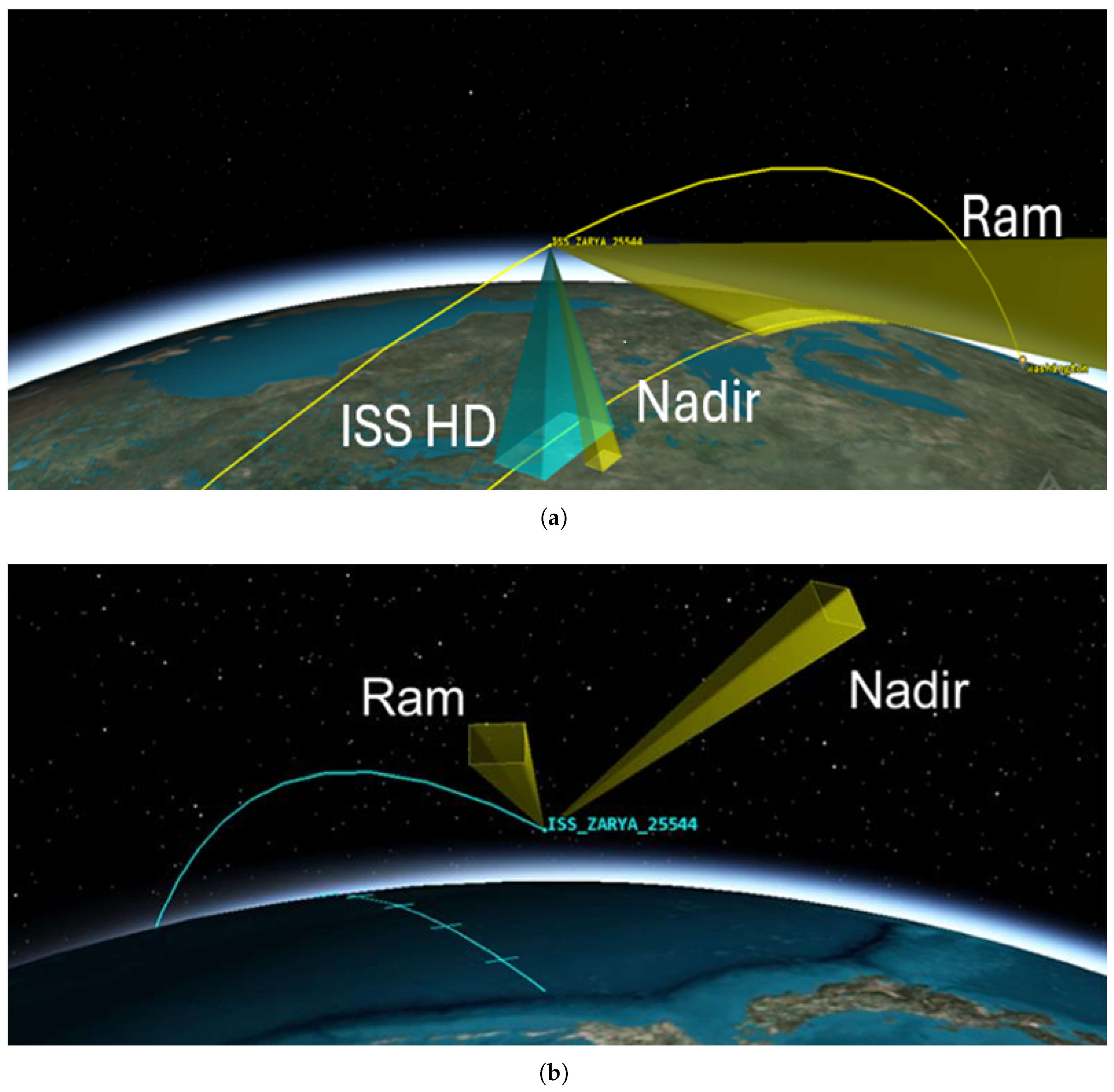


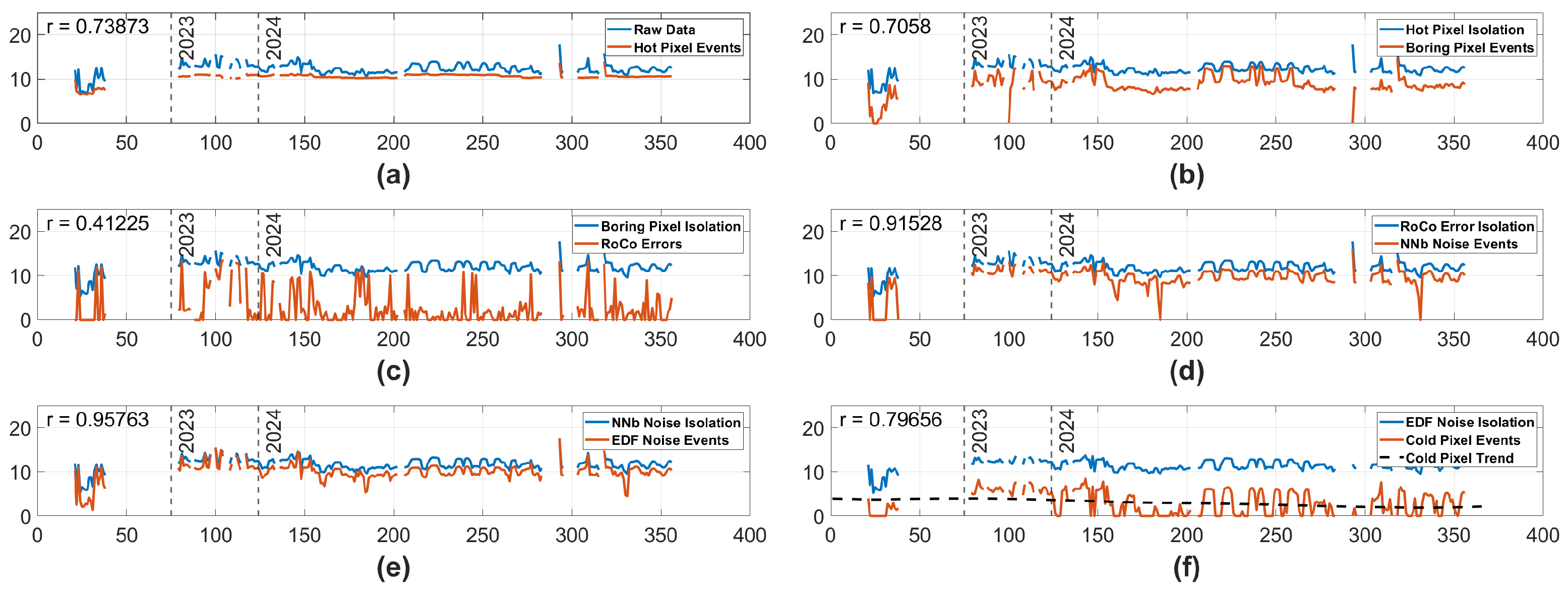
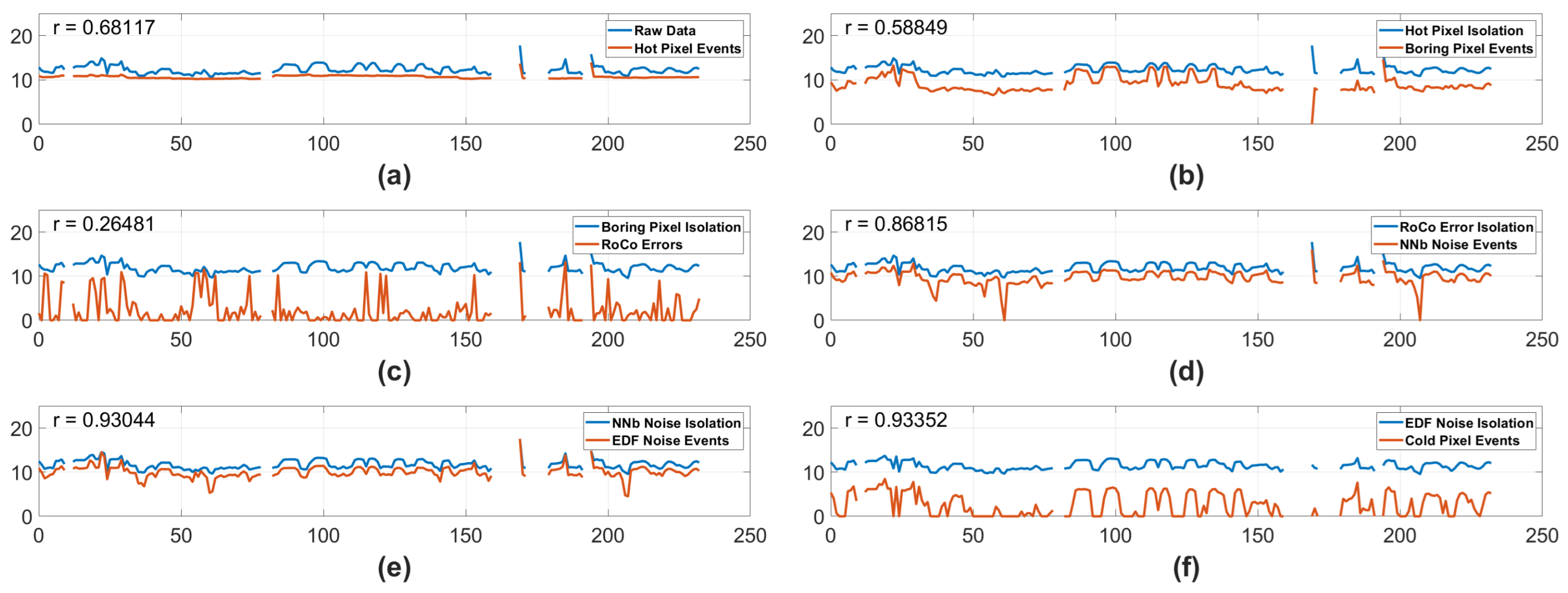

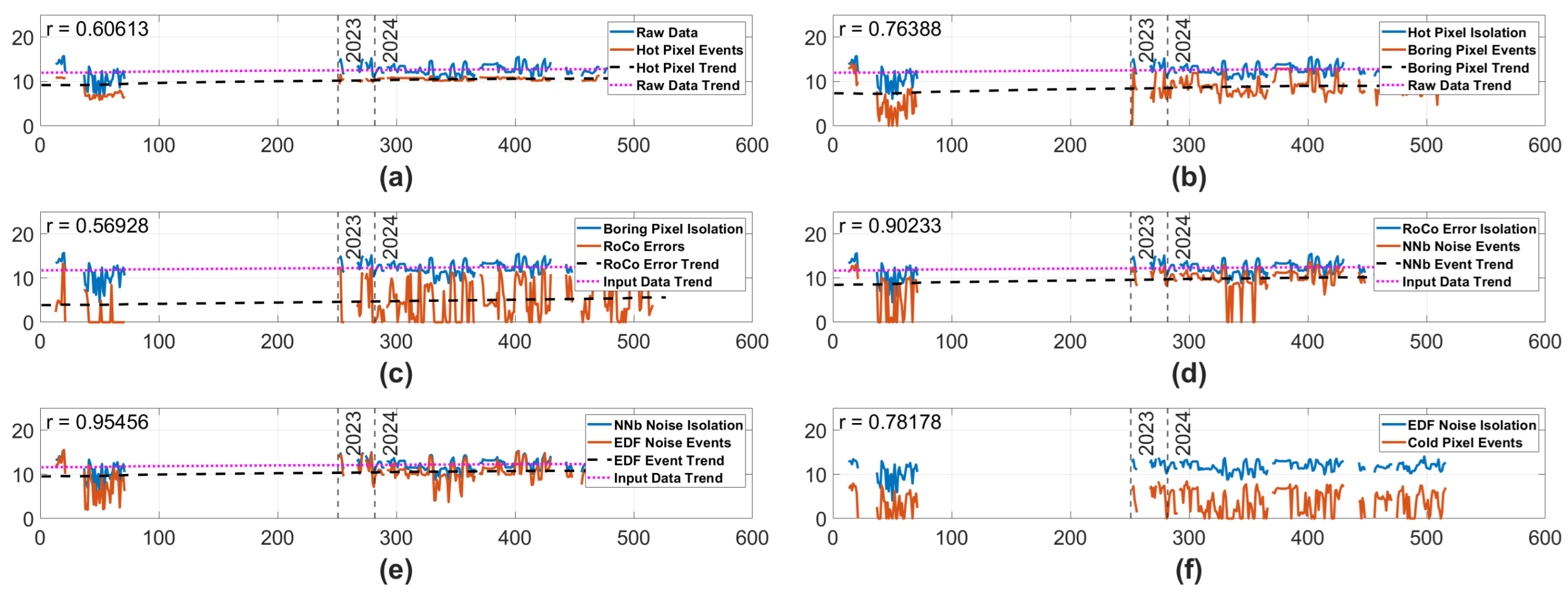
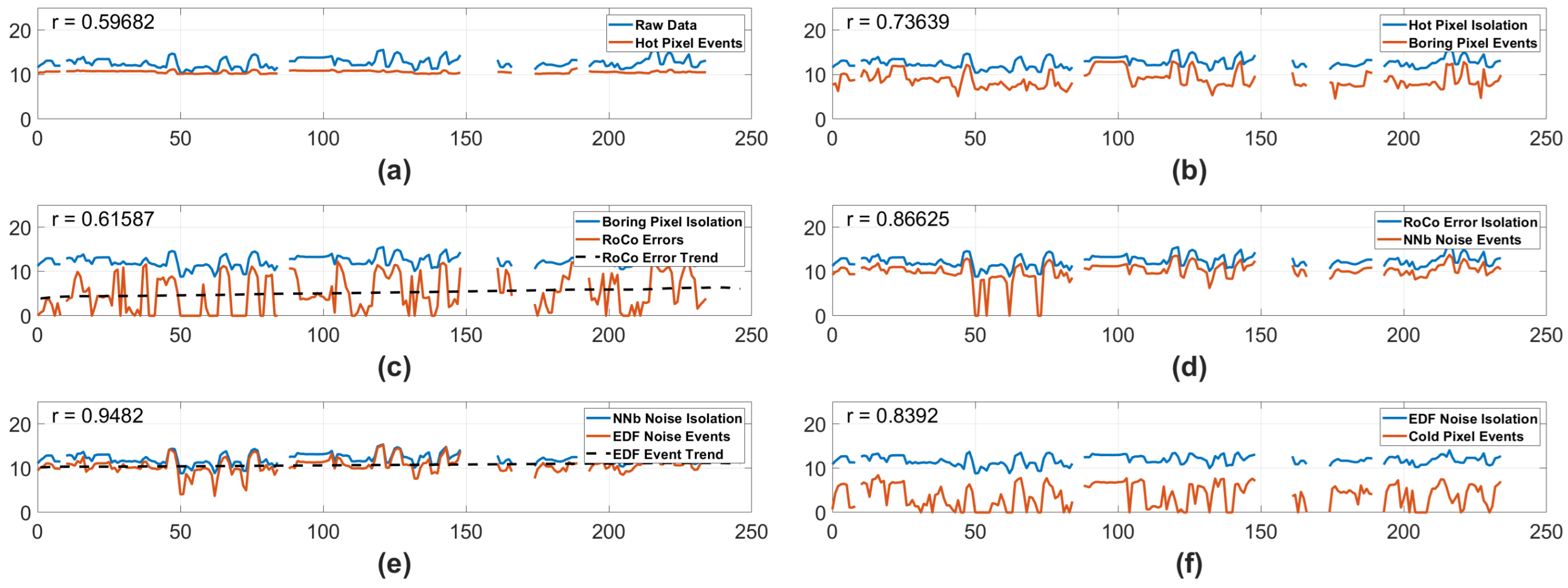
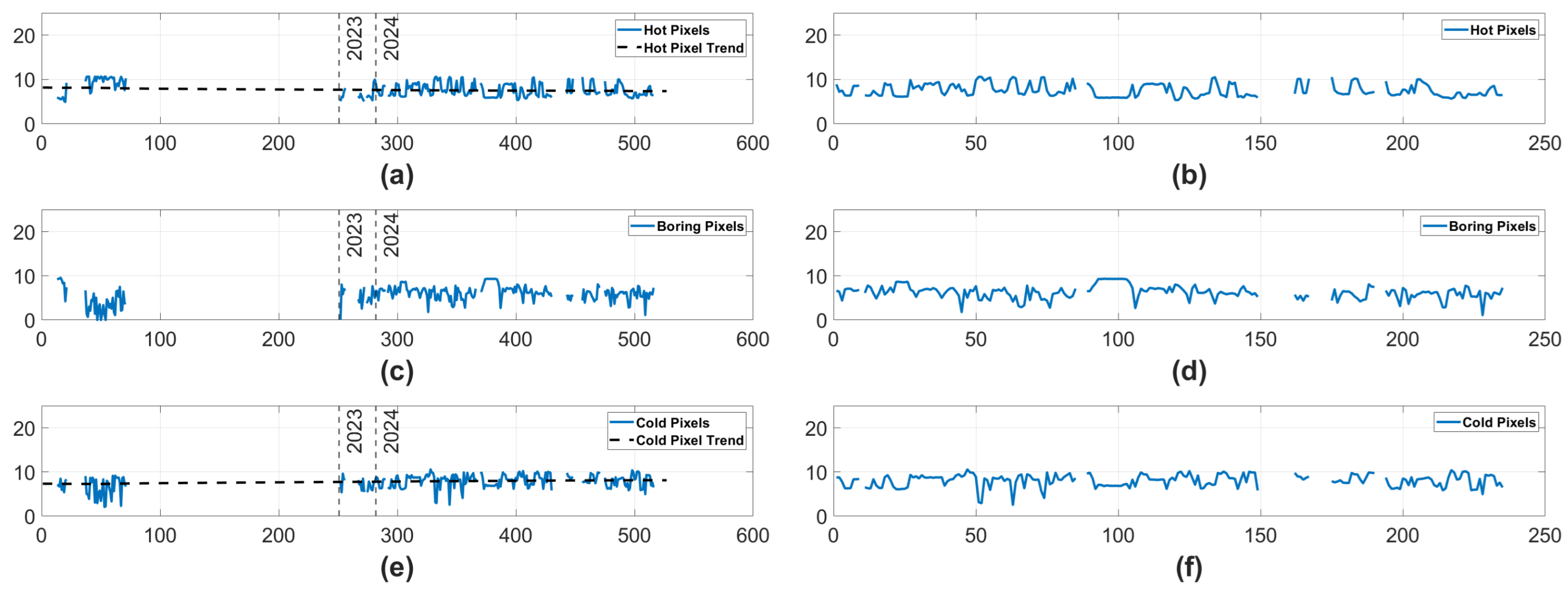
Disclaimer/Publisher’s Note: The statements, opinions and data contained in all publications are solely those of the individual author(s) and contributor(s) and not of MDPI and/or the editor(s). MDPI and/or the editor(s) disclaim responsibility for any injury to people or property resulting from any ideas, methods, instructions or products referred to in the content. |
© 2025 by the authors. Licensee MDPI, Basel, Switzerland. This article is an open access article distributed under the terms and conditions of the Creative Commons Attribution (CC BY) license (https://creativecommons.org/licenses/by/4.0/).
Share and Cite
Wilcox, Z.; Graca, R.; McReynolds, B.; Williams, J.; Afshar, S.; Marcireau, A.; McHarg, M.G.; Cohen, G. Event-Based Vision Sensor Lifetime Degradation in Low Earth Orbit. Sensors 2025, 25, 6599. https://doi.org/10.3390/s25216599
Wilcox Z, Graca R, McReynolds B, Williams J, Afshar S, Marcireau A, McHarg MG, Cohen G. Event-Based Vision Sensor Lifetime Degradation in Low Earth Orbit. Sensors. 2025; 25(21):6599. https://doi.org/10.3390/s25216599
Chicago/Turabian StyleWilcox, Zachary, Rui Graca, Brian McReynolds, John Williams, Saeed Afshar, Alexandre Marcireau, Matthew G. McHarg, and Gregory Cohen. 2025. "Event-Based Vision Sensor Lifetime Degradation in Low Earth Orbit" Sensors 25, no. 21: 6599. https://doi.org/10.3390/s25216599
APA StyleWilcox, Z., Graca, R., McReynolds, B., Williams, J., Afshar, S., Marcireau, A., McHarg, M. G., & Cohen, G. (2025). Event-Based Vision Sensor Lifetime Degradation in Low Earth Orbit. Sensors, 25(21), 6599. https://doi.org/10.3390/s25216599





